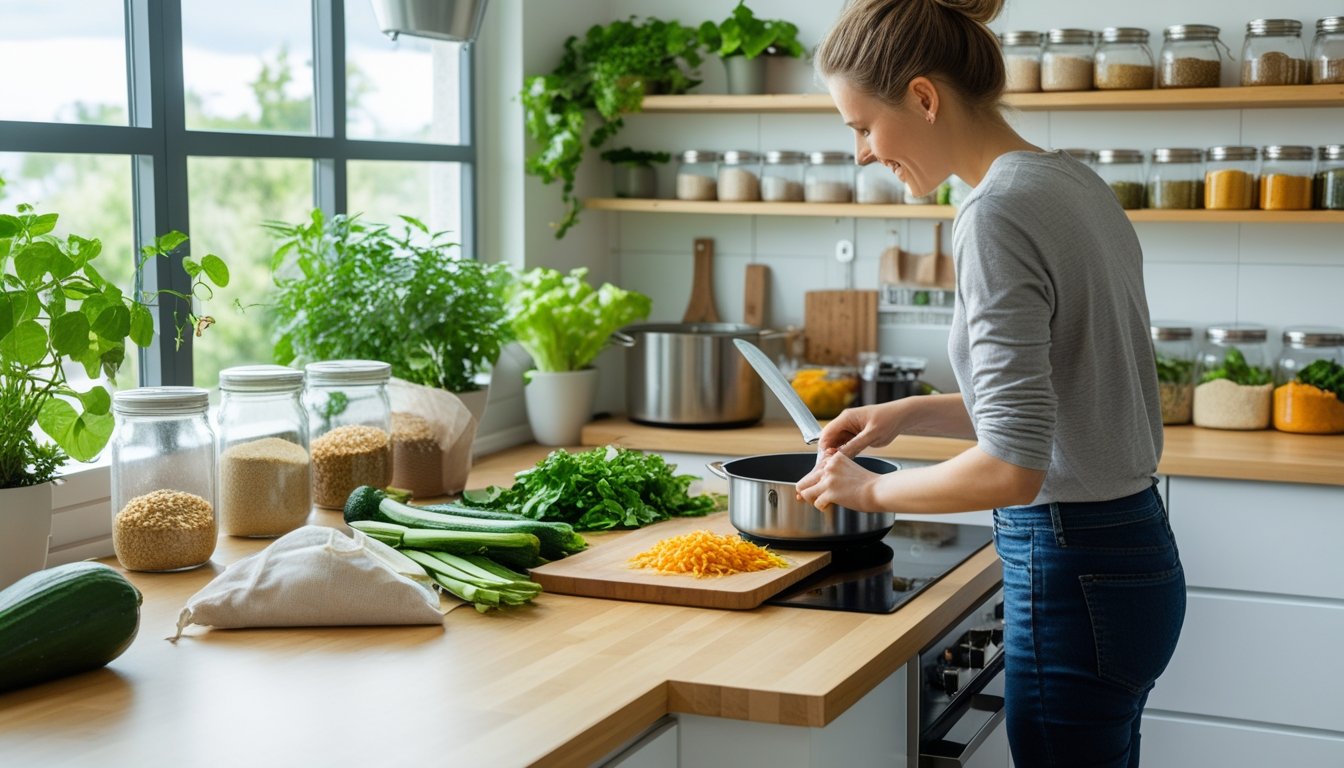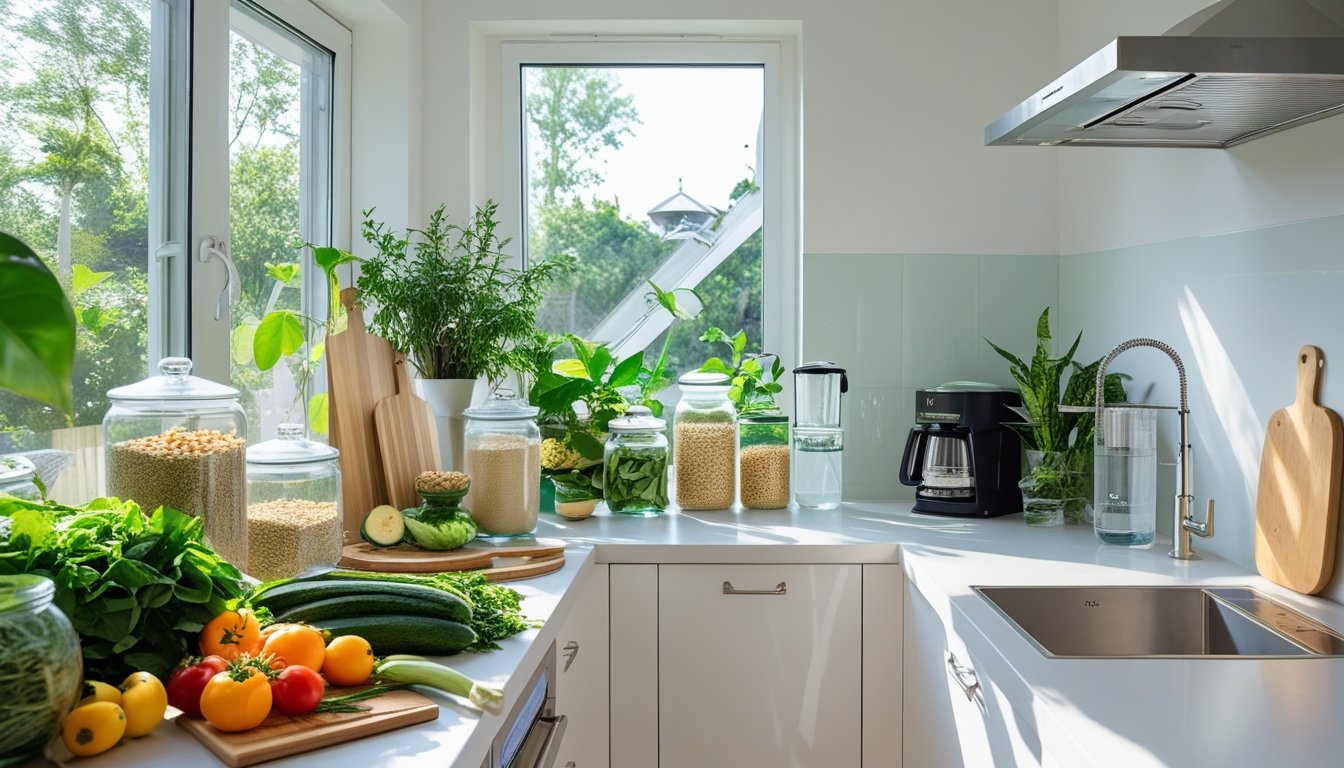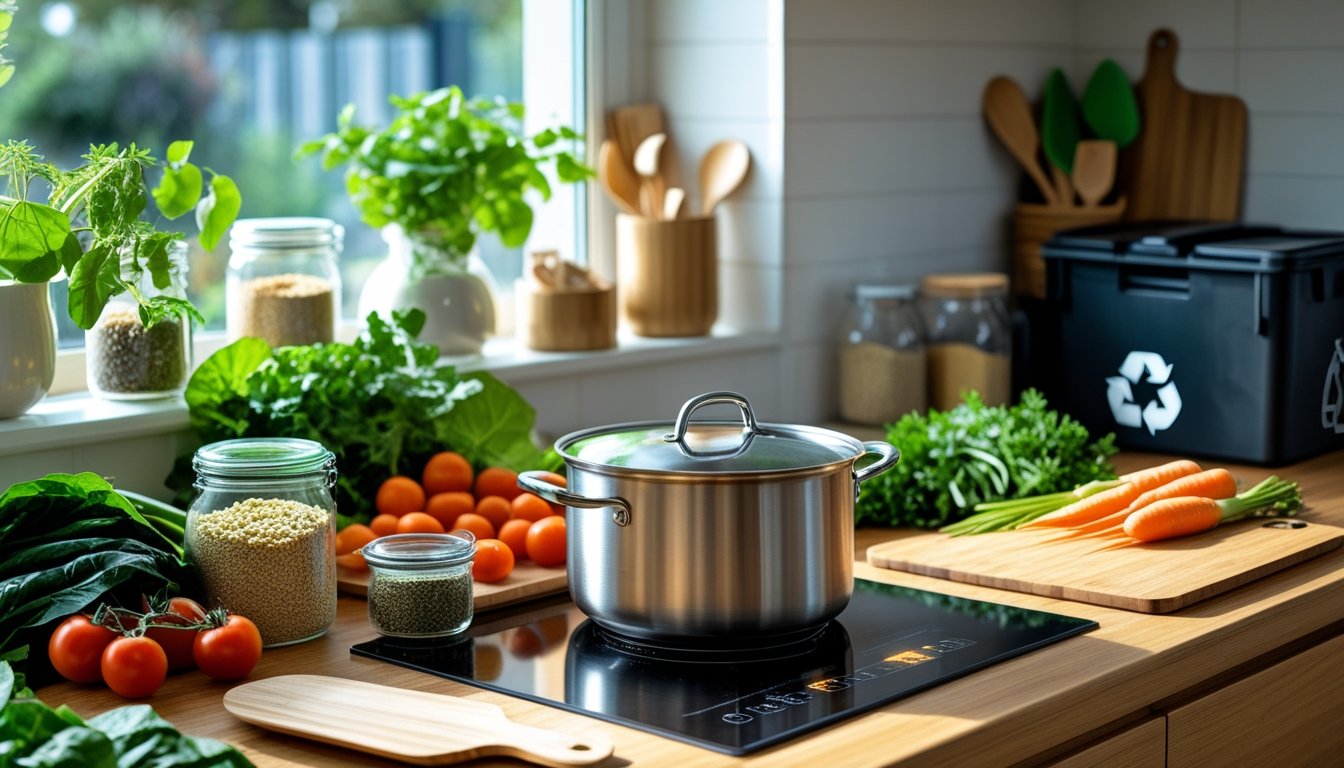Late updated: 19 Aug 2025 10:08
Written by: Sarah Hollister
Eco-Friendly Cooking Tips For A Sustainable Kitchen: Simple Changes For A Greener Home
Embarking on the journey towards a sustainable kitchen is more than just a trendy choice; it's a commitment to our planet and future generations. Every decision we make in the kitchen, from selecting eco-friendly appliances to opting for reusable materials, has a substantial impact. The simplest shifts in our cooking habits can significantly reduce waste and conserve precious resources.

Adopting sustainable cooking methods not only benefits the environment but also ensures that we consume nourishing, wholesome meals. Exploring options like using energy-efficient appliances and incorporating seasonal produce can immensely enhance our cooking practices. These changes foster a kitchen atmosphere that's respectful of both our health and the ecosystem around us.
There's no need for drastic kitchen overhauls; meaningful impact can start with small, intentional modifications. With a practical approach and mindful choices, we can transform our kitchens into vibrant hubs of sustainability. This guide delves into these elements, offering actionable tips to make eco-friendly cooking an integral part of our daily lives.
Key Takeaways
- Small changes make a big environmental impact.
- Eco-friendly practices support health and sustainability.
- Aim for consistency, not perfection.
Core Eco-Friendly Cooking Tips For A Sustainable Kitchen
Sustainable cooking practices are vital in reducing our environmental footprint. By integrating mindful meal planning, using local and seasonal ingredients, minimising food waste, and opting for energy-efficient appliances, we can significantly cut down on resource consumption.
Reducing Carbon Footprint with Smart Meal Planning
We can lower our carbon footprint through strategic meal planning. This involves planning meals ahead to reduce unnecessary shopping trips and food wastage.
Creating a weekly meal plan can aid in purchasing only what's needed, reducing impulse buying. Batch cooking is another excellent strategy, allowing us to cook in bulk, thus saving time and energy throughout the week. Also, incorporating more plant-based meals reduces reliance on meat, which is often associated with higher carbon emissions.
Utilising Local and Seasonal Produce
Sourcing produce locally and seasonally not only supports local farmers but also cuts down on transportation emissions. Seasonal produce is generally fresher, more nutritious, and less expensive.
We should make an effort to visit local farmers' markets, where seasonal ingredients are likely to be more readily available. Understanding the seasons for different fruits and vegetables helps us plan meals that are both sustainable and flavourful, aligning with our eco-friendly cooking goals.
Minimising Food Waste and Making the Most of Leftovers
Reducing food waste is a core tenet of eco-friendly cooking. This can be achieved by planning meals that utilise ingredients across multiple dishes, ensuring everything bought is used.
Another strategy is to creatively repurpose leftovers to make new meals. For instance, leftover vegetables can be transformed into delicious soups or stir-fries. By composting food scraps, we further reduce waste while enriching garden soil, promoting a circular approach to cooking.
Energy-Efficient Cooking Techniques and Appliances
Using energy-efficient appliances like induction cooktops and convection ovens can significantly decrease energy consumption in the kitchen. These appliances are designed to cook food faster while using less energy.
We can also embrace energy-saving techniques such as using pressure cookers or slow cookers, which maintain temperature effectively. These methods allow us to cook meals evenly and efficiently, supporting our commitment to sustainable cooking practices and reducing our environmental footprint.
Key Practices for Maintaining a Sustainable Kitchen

For a truly sustainable kitchen, we can integrate eco-friendly cookware, innovative storage solutions, and efficient water-use strategies. Emphasising homegrown ingredients further enhances sustainability.
Eco-Friendly Cookware and Utensils
Choosing eco-friendly cookware is a crucial step. Cast iron, stainless steel and ceramic cookware are excellent choices due to their durability and non-toxic nature. These materials distribute heat efficiently, reducing cooking time and saving energy. We can opt for bamboo or wooden utensils instead of plastic ones, which not only last longer but are also biodegradable.
It's important to look for products with certifications guaranteeing they are free from harmful chemicals. By investing in quality items, we reduce waste and ensure our kitchen tools align with sustainable practices, contributing to a more eco-friendly kitchen environment.
Sustainable Food Storage Solutions
Moving towards sustainable food storage involves replacing single-use items. Reusable beeswax wraps are a great alternative to plastic wrap, as they are naturally biodegradable and can be used multiple times. Airtight containers, preferably glass or silicone, help in keeping food fresh without the need for plastic bags.
Labelling containers with dates can aid in reducing food waste by reminding us to use items before they spoil. Keeping a compost bin for organic waste allows us to turn scraps into nutrient-rich compost, beneficial for our gardens.
Water Conservation Methods in the Kitchen
Water conservation is key in maintaining a sustainable kitchen. Installing a low-flow aerator on taps is a simple change that significantly reduces water usage without compromising pressure. Collecting excess water from rinsing vegetables to water plants is another practical tip.
When washing dishes, using a basin instead of letting water run continuously conserves substantial amounts. These methods not only contribute to water conservation but also lead to financial savings over time.
Growing Your Own Ingredients
Cultivating our ingredients is both rewarding and sustainable. A backyard garden can be a source of fresh, nutritious produce, reducing reliance on store-bought goods and lowering our carbon footprint. Even with limited space, a community garden offers an opportunity to grow plants while fostering community bonds.
Urban dwellers can utilise windowsills or small balconies to grow herbs and small vegetables. Incorporating homegrown ingredients into our meals ensures freshness and enhances the nutritional value. This practice supports biodiversity and encourages a healthier lifestyle.
Frequently Asked Questions

Exploring sustainable cooking involves embracing methods that minimise environmental impact, encouraging eco-friendly dining, and responsibly sourcing meat. We also examine ways to inspire teenagers towards sustainability and what to consider in choosing sustainable restaurants.
What are the most effective methods for sustainable cooking?
Effective methods include using seasonal and local ingredients, reducing food waste, and employing energy-efficient cooking techniques. Incorporating plant-based meals can also significantly decrease the carbon footprint.
Why should we consider the importance of sustainable cooking practices?
Considering sustainable practices is vital because food production and preparation significantly contribute to environmental issues. By making small changes, we can help conserve resources and reduce pollution.
How can one encourage teenagers to appreciate and practice food sustainability?
Engage teenagers by involving them in meal planning and cooking. Showing them the benefits of reducing waste and introducing them to exciting plant-based recipes can spark an interest in sustainability.
What are the best practices for eco-friendly dining?
Opt for restaurants that provide seasonal menus and use locally sourced ingredients. Support establishments that embrace zero-waste practices and offer plant-based options. Bringing your own containers for leftovers can also help minimise waste.
How can we source and consume meat in an environmentally responsible way?
Choose grass-fed or pasture-raised meats from local farms that practice sustainable farming methods. Additionally, reducing overall meat consumption and opting for smaller, more environmentally friendly portions can have a positive impact.
What should one look for when choosing a sustainable restaurant?
Look for certifications such as organic, Fair Trade, or LEED. Assess the restaurant's commitment to reducing waste, such as composting and recycling programmes. Transparency about ingredient sourcing and practices is also a good indicator of sustainability.
